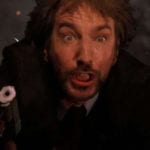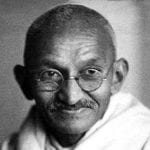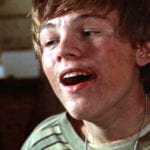 Movies and TV
Movies and TV  Movies and TV
Movies and TV  History
History 10 Things You Didn’t Know About the American National Anthem
 Technology
Technology Top 10 Everyday Tech Buzzwords That Hide a Darker Past
 Humans
Humans 10 Everyday Human Behaviors That Are Actually Survival Instincts
 Animals
Animals 10 Animals That Humiliated and Harmed Historical Leaders
 History
History 10 Most Influential Protests in Modern History
 Creepy
Creepy 10 More Representations of Death from Myth, Legend, and Folktale
 Technology
Technology 10 Scientific Breakthroughs of 2025 That’ll Change Everything
 Our World
Our World 10 Ways Icelandic Culture Makes Other Countries Look Boring
 Misconceptions
Misconceptions 10 Common Misconceptions About the Victorian Era
 Movies and TV
Movies and TV The 10 Coolest Stars to Set Sail on The Love Boat
 History
History 10 Things You Didn’t Know About the American National Anthem
 Technology
Technology Top 10 Everyday Tech Buzzwords That Hide a Darker Past
Who's Behind Listverse?

Jamie Frater
Head Editor
Jamie founded Listverse due to an insatiable desire to share fascinating, obscure, and bizarre facts. He has been a guest speaker on numerous national radio and television stations and is a five time published author.
More About Us Humans
Humans 10 Everyday Human Behaviors That Are Actually Survival Instincts
 Animals
Animals 10 Animals That Humiliated and Harmed Historical Leaders
 History
History 10 Most Influential Protests in Modern History
 Creepy
Creepy 10 More Representations of Death from Myth, Legend, and Folktale
 Technology
Technology 10 Scientific Breakthroughs of 2025 That’ll Change Everything
 Our World
Our World 10 Ways Icelandic Culture Makes Other Countries Look Boring
 Misconceptions
Misconceptions 10 Common Misconceptions About the Victorian Era
10 Movies That Totally Changed Course Midway
Many films have shocking twists and turns, but occasionally, there will be a movie that will drastically change course in the middle of the story. It essentially turns into a different kind of picture, sometimes even switching genres. Whatever our overall impression of such a film, whether we ultimately find it entertaining or disappointing, at least it’s not predictable.
Let’s dive right in and looks at ten movies that changed course midway. Warning: spoiler alert.
Related: 10 Ridiculous Movie Plots That Just Don’t Add Up
10 From Dusk Till Dawn
The 1996 action/horror film From Dusk Till Dawn, starring George Clooney, Quentin Tarantino, Juliette Lewis, and Harvey Keitel, starts out as a movie about bank robbers who hide out in Mexico with a family they’ve taken hostage. When the crooks are lying low in a topless bar, it suddenly turns into a vampire flick, and they must battle the living dead to escape. It’s something along the lines of Bonnie and Clyde meets Dracula, except gorier and more violent.
As Felix Vasquez of Cinema Crazed put it in his review: “The second half will completely blow away anyone entrenched in the crime drama that is the first half of the film.”
It’s not surprising that Tarantino also wrote this peculiar genre mash-up movie or that it was directed by the unconventional Robert Rodriguez. The latter eventually developed the 2014–2016 TV show From Dusk Till Dawn: The Series.[1]
9 Music Box
The 1989 crime drama Music Box appears to be a movie about a lawyer, Ann Talbot (Jessica Lange), fighting the extradition of her Hungarian-born father, Mike Laszlo (Armin Mueller-Stahl), who is being framed for war crimes by his enemies. As evidence mounts against the beloved Mike, this movie turns into the tale of a daughter grappling with the knowledge that her father may not be the man she thought he was and the impact this has on their relationship.
While Music Box briefly returns to the original track when Ann convinces herself of her father’s innocence, she is soon blindsided by the clearest and most damning evidence of all—something that is too impossible to ignore.[2]
8 Shadow of a Doubt
Like Music Box, Alfred Hitchcock’s 1943 suspense classic Shadow of a Doubt begins as a story of a young woman trying to prove the innocence of a beloved family member. In this case, it’s her uncle, in town for what turns out to be an extended visit. Charlie (Teresa Wright) fiercely defends her Uncle Charles (Joseph Cotten) when she learns he is being investigated by undercover policemen, who suspect he may be a serial killer. She must finally accept the fact that her uncle is, in fact, the notorious “Merry Widow” murderer and goes from her role as protective niece to potentially his next victim.
Charlie’s reaction to the discovery of who her uncle really is leads her to insist he leave town, even threatening to kill him if he does not go. The only reason she does not turn him into the police is that she believes it would destroy her mother to find out something so horrible about her own brother. However, Uncle Charles has decided to take up permanent residence in the town and attempts to get rid of his niece.[3]
7 The World’s End
The 2013 action comedy The World’s End, starring Simon Pegg and Nick Frost, is a good example of a film that not only significantly changed course but also switched genres. At first, we are watching a movie about old friends who get together intending to try to top their epic drinking marathon which had taken place twenty years earlier. Their final destination is a pub called The World’s End, but when the story turns into an apocalyptic tale, the group is actually faced with the strong possibility that the world is about to come to an end.
As RogerEbert.com says: “The film takes a right turn into science fiction conspiracy thriller territory—invoking Invasion of the Body Snatchers as well as such Carpenter films as The Fog and Prince of Darkness.”
The focus of this wacky British romp from director Edgar Wright (Shaun of the Dead) strikingly changes from an attempt by a group of middle-aged drinking buddies to revisit their youth to a special effects-loaded adventure in which the characters are tasked with saving the world.[4]
6 Gone Girl
When the 2014 thriller Gone Girl changes course, it is an ingenious twist that is probably the thing we remember most about this Ben Affleck, Rosamund Pike film. It initially presents itself as being about the search for a missing woman. While the search for Amy Dunne (Pike) and the scrutiny of her unfaithful husband, Nick Dunne (Affleck), goes on for the majority of the picture, it is revealed to the audience much earlier that Amy, narrating the story, has actually run away and set up her husband to look like a murderer.
Although this shocking truth is disclosed long before the end, it does not hurt the suspense. This is actually just one of many strange twists and turns in the eventful film, written by Gillian Flynn and directed by David Fincher, which keeps us guessing throughout.[5]
5 Duplex
The 2002 Ben Stiller, Drew Barrymore farce Duplex is a strange little movie that begins as a romantic comedy and goes to some disturbing places, never quite making it back to the lighthearted tone experienced in the first third of the story. New Yorkers Alex Rose and Nancy Kendricks are a charming, lovable young couple, ready to start a family, who buy what seems like a great house. The catch is that it’s actually a duplex with an impossible tenant, who they cannot evict, occupying the rent control apartment upstairs.
At first, Mrs. Connelly (Eileen Essell) seems like a sweet but eccentric old lady. But it soon becomes clear that she is much, much more than that, enough to drive Alex and Nancy out of their minds. The continuous sleep deprivation caused by her all-night TV blasting, damage to their careers, and the other forms of torture inflicted on Alex and Nancy lead this film into the category of black comedy, which is familiar territory for director Danny DeVito. When their efforts to hasten Mrs. Connelly’s demise—trying to infect her with a particularly severe form of the flu—don’t work, the couple resorts to hiring a hitman. However, she proves to be much tougher and craftier than she appears.[6]
4 Vertigo
Another Alfred Hitchcock film that turns into a very different kind of movie about halfway through is the 1958 psychological thriller Vertigo, starring James Stewart and Kim Novak. It’s about a former police detective, John “Scottie” Ferguson, who is persuaded by an old friend to trail his emotionally disturbed wife, Madeleine. After rescuing Madeleine when she attempts to drown herself in San Francisco Bay, Scottie quickly falls in love with her. Shortly into their romance, tragedy strikes. Scottie, unable to reach Madeleine quickly enough due to his debilitating vertigo, witnesses her successfully commit suicide by jumping off a building.
When Scottie later meets another woman, Judy, with an uncanny resemblance to Madeleine, he becomes obsessed with her. Suddenly, we find ourselves watching a twisted film about a man trying to re-create his former lover by making over his new girlfriend. But there are even more surprises ahead, including the truth about Madeleine’s look-alike.[7]
3 Bunny Lake Is Missing
In the 1965 Otto Preminger-directed mystery about the search for a missing child, Bunny Lake, we are gradually led to believe the little girl’s mother, Ann (Carol Lynley), is actually a delusional woman whose daughter is just a figment of her imagination. But, as the film goes on, we realize this is not a movie about a mentally ill woman looking for a little girl who never existed, but something very different and unexpected.
Newly arrived in London from America, Ann is surrounded by strangers, and although police initially search for the missing four-year-old Bunny, they soon suspect there is no child after all. We learn, however, that Bunny is very real. While Ann is perfectly sane, there is a deranged character who has orchestrated a kidnapping and undermined Ann’s credibility to throw off the authorities. As the truth is revealed to us in the middle of the film, it changes from a mystery into a story about a woman desperately trying to save her child.[8]
2 The Village
The Village basically changes into another movie at a certain point. The setting of the film is revealed to be more or less an illusion. However, it is so cleverly written and directed by M. Night Shyamalan that despite the paranormal aspect of the storyline, we do not question the authenticity of what we are watching, so the sudden twist is very effective.
The 2004 thriller, featuring an all-star cast that includes Bryce Dallas Howard, Joaquin Phoenix, Adrien Brody, and William Hurt, centers on residents of a 19th-century village and their fear of the mysterious beings who inhabit the surrounding forest. A young, blind woman, Ivy Walker (Howard), is granted permission to leave their isolated village and go to the other side of the forest in order to obtain medicine for her injured fiancé. What Ivy discovers is very different and much bigger than what she or the audience is anticipating.[9]
1 Psycho
“We all thought it was a picture about a woman who steals some money… the audience—a thousand paying customers—shrieked through the entire sequence,” said filmmaker Peter Bogdanovich, recalling a press screening he attended of Psycho.
Possibly the most shocking example of a movie that dramatically changed course in the middle is the most famous Alfred Hitchcock film, the horror/suspense masterpiece Psycho. Today, everyone, even those who have never actually seen Psycho, knows that it is about a serial killer. Norman Bates (Anthony Perkins) has a habit of dressing up as his late mother and killing desirable young women unfortunate enough to check into his motel, including Marion Crane (Janet Leigh). However, when the film was released in 1960, audiences were caught completely off guard.
Part of the reason Marion’s murder was so unexpected at the time is that it was unheard of to kill off the star one-third of the way through a film. Another unusual aspect was the graphic violence of the now-famous shower scene, considered a milestone in filmmaking. The most surprising part of all may be the switch from what appears to be a movie about a secretary embezzling money to a story about a psychopath who murders women while assuming the identity of his late mother.
Given this gigantic twist, it was essential that the real plot of the picture be kept under wraps for as long as possible. There were posters and recordings of Hitchcock’s voice in the theater lobby, asking attendees to not give away the ending to their friends.
It was also forbidden for moviegoers to enter the auditorium after Psycho started, in case they missed the leading lady’s entire performance in the first third of the movie and started whispering, “‘When is Janet Leigh coming on,” according to Bogdanovich.[10]








